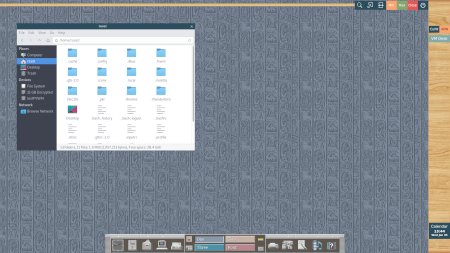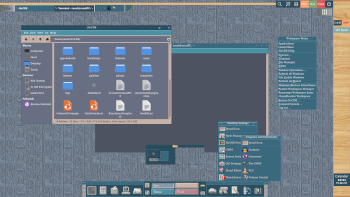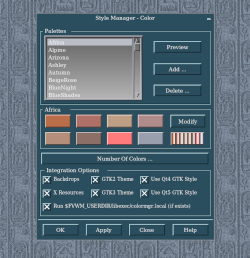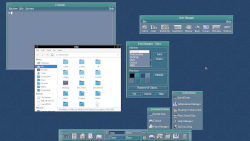I noticed a nice behavior with the workspace view panel (above screenshot) when a page is selected. The panel hides. How it is done? I assume this is different from autohide function.
Hi @rasat
Local Pager will show just above Front Panel when you click some workspace, or (by default, if infostore variable rootpagerposition is not changed) at the top of the screen if InfoStoreAdd pageshowrootpager is set to 1 in ~/.NsCDE/NsCDE.conf. It will stay on the screen as long as it has pointer above the pager window. If pointer is lost, counter starts to count down $[infostore.rootpagertimeout] (2 seconds by default). It is not 100% perfect (sometimes steals focus, gets on the way …), but it serves the purpose.
Functions for this are a bit complicated and fuzzy. They are in /share/NsCDE/fvwm/Functions.fvwmconf. See f_StartLocalPager f_ShowLocalPager and f_HideLocalPager.
Thanks, got the idea.
Another question, the page labels (One, Two, Three, etc. ) on the panel… how to?
Hi @rasat
How to … what? I’m not sure I understand your question. How to rename it? Use it?
Just asking how it’s done in NsCDE because in Fvwm3 the page labeling is not there.
Had a look at your codes, got the idea. How I now did it in one of my configs, by Swallow Fvwmpager into FvwmButtons that have above and below label buttons. I like the previous FvwmPager opinion, such as…
*FvwmPager: Label 1 Mail
*FvwmPager: Label 2 Office
*FvwmPager: Label 3 Music
This morning I used the NsCDE including adding myExt configs for a test run. All works fine. Actually, I like the combination of the two. Found also another great feature in NsCED. The Subpanel Manager to add selected apps to the panel.
When loading myExt configs, NsCDE does not include Fvwm3 variable $[FVWM_USERDIR]. To setEnv…
SetEnv FVWM_USERDIR $[HOME]/.fvwm
I hope you don’t mind seeing NsCDE with a different look generated by the myExt configs.  As I said, I love the features/tools of NsCDE but with a different look.
As I said, I love the features/tools of NsCDE but with a different look.

Yes, FvwmPager “Label” was deprecated and now discontinued in FVWM 3. If you see the man page of FvwmPager, you will see this:
“Note: There is currently a much better way to specify desk names globally (and not just in FvwmPager) using DesktopName command, so you should not use this option anymore.”
So, when using DesktopName for every desk (workspace in NsCDE), it will automatically put this names in FvwmPager, and can be used with $[deskX.name] (where X is number from 0 to some-max) avoiding copying the same information on different places. For example Workspace Manager in the middle of Front Panel uses this same info as FvwmPager based pagers in NsCDE, as well as WindowList.
And no, I don’t mind seeing people customize FVWM (and NsCDE on the top of it) to their needs. This is all about having free and such flexible frameworks for building interfaces as we like.
For example, NsCDE can be customized in $HOME/.NsCDE ($FVWM_USERDIR) without even touching it’s installation - lightly by appending and chaning default configs with .fvwlocal files, or complitely overriding them by placing own copy of .fvwmconf file in ~/.NsCDE, which will be read with bigger priority than the one in /usr/local/share/NsCDE/fvwm. This way you may probably incorporate and join things together. I also use Functions.fvwmlocal, Style.fvwmlocal and such for my own things which are not of general iterest to be put in NsCDE.
BTW, this file manager on the screenshot, I don’t know which one is it, but it doesn’t use NsCDE or Qt theme. If this is not intentionally, you are probably missing GTK pixmap or qt5 style plugins.
The theme of Thunar filemanger is intentionally made with lxappearance (.config/gtk-3.0/settings.ini). This is why I asked not to mind about a none NsCDE look. It’s part of the default myExt look which anyone can change.
Instead of me “reinventing” with new configs that NsCDE already does that many medium-advanced users are expecting to have in a WM, it will be nice to use NsCDE. The memory usage remains the same (appx. 350). Access to choices and customization with functional possibilities to speed up the window management and workflow has been my aim.
EDIT
About .fvwlocal files. I want NsCDE to complete its run and then load myExt configs. Do I add .fvwlocal in $HOME/.NsCDE ??
NsCDE treats various aspects of fvwm configuration separately: Functions, Backer, Styles, Key bindings, Mouse bindings, Menus, Panel … you can spread your extensions or configs into this scheme, or simply “Read” it from the ~/.NsCDE/Init.fvwmconf InitFunction - this will be really last executed during startup.
How this works, please see section 2 of the NsCDE manual: “Components of the NsCDE”. PDF or HTML.
This is great!!
It took some work to change all myExt configs with a new variable. I was wondering why taking 10 sec to load NsCDE with myExt which usually is 2-3 sec. Also, .fvwm is filled with NsCDE stuff. I changed “FVWM_USERDIR $[HOME]/.fvwm” to “myEXT_USERDIR”. It made a big difference.
In .NsCDE I created one new file: Ext.fvwmlocal with command READ from Init.fvwmconf. Ext.fvwmlocal content is the same as the config which READ all configs in [HOME]/.fvwm, including changes of preloaded configs to adjust with NsCDE.
Works very well and is easy to manage. Took some time to combine NsCDE and myExt Colorsets but got a good start. Check the full screenshot.

Here are my suggestions and addons
- A year ago I brought up one major concern that NsCDE takes over the appearance settings of WMs and DEs. Many spend hours to setup their KDE or Xfce and suddenly it’s gone. This is caused by the default setting of all “Integration Options” as tagged. A new user may not be aware of untagging as per their choice. I suggest for the default options to be untagged, except the “Run …/colormgr.local”. If anything goes wrong is for the user to take care of.

Preferable suggestion is for NsCDE at startup, to create a backup of $[HOME]/.config/gtk-3.0/settings.ini, $[HOME].gtkrc-2.0, etc. and restore them at logout/exit.
- Style Manger - Color gives limited choices to colorset each element differently. With 8 colors divided into groups, for example, Broica:
#ed00a8007000 -- Active window
#9900991b99fe -- SubMenuPanel bar, Inactive Window, Menu list
#89559808aa00 -- Workspace 1
#68006f008200 -- Scroll menu, File Manager background
#c600b2d2a87e -- FrontPanel, SubMenu list, Workspce 2
#49009200a700 -- Dialog box, Workspace 3
#b70087008d00 -- Workspace 4
#938eab73bf00 --
It is better to keep the Inactive Window and Menu list separate. The Fvwm3 default colorset numbers allow users to have, for example, a light inactive window title bar and a darker menu list (including MenuStyle colors), which is preferable. I am also suggesting keeping FrontPanel and SubMenu list with separate colorset numbers.
- The color coding is confusing with 12 digits compared to HTML 6 digits which do the same and are commonly used.
#eda870 -- Active window
#999999 -- SubMenuPanel bar, Inactive Window, Menu list
#8998aa -- Workspace 1
#686f82 -- Scroll menu, File Manager background
#c6b2a8 -- FrontPanel, SubMenu list, Workspce 2
#4992a7 -- Dialog box, Workspace 3
#b7878d -- Workspace 4
#93abbf --
-
Style Manger - Backdrop… has 168 wallpapers. All are of different gray colors. I suggest reducing the number of wallpapers and to include other colors.
-
Style Manager - Color… has 78 colorset groups. Reduce the number of similar coloring for users to find and make modifications.
-
Add an option to disable the NsCDE start-up fullscreen banner. Not only gets tiring but configs with “Style StaysOnTop” are on top of the banner. Or a smaller banner appearing in the center.
-
Add an option to disable the hourglass icon.
Note: I found another interesting feature… vertical and horizontal window tiling. Some users have been asking for this.
Hi
I will answer in the order by which you constructed your concerns:
-
Making I/O on every login/logout is a bit clumsy. gtkrc and similar files are NEVER totally overwritten if they exist prior to first run of the NsCDE. If they don’t exist, they are created. Second: chaging couple options (theme, icon theme, font) there is thing many DE’s and tools do anyway, so novice users can easly change this back with the tools of other DEs without touching $EDITOR and terminal. In a nutshell, there is no damage here (and I take great care in that aspect) where some rare option or setting can be lost, and novice user left with behaviour which cannot be restored with couple of clicks. This files are not meant to by edited only manually anyway. In the early days of NsCDE, Color Style Manager Integration Options were all unset, but this meant great amount of users will not understand or bother to enable them, and will get GTK, Qt, and the rest apps in default state, or the state configured by the previous DE. For such behaviour, one can also use old original CDE, there is no point of having NsCDE then in that respect.
-
Style Manager exactly follows CDE coloring scheme in 4 and 8 colors mode, even giving some meta choices in “Number of Colors …” dialog, which were present in one or another version of CDE during time. Any diversion from this scheme is something that can be extended and overriden by the user in fvwmlocal files - so it is possible for those who want it. That is to say, you can re-configure Workspace Menu or any other menu is some other or custom color in Style.fvwmlocal.
-
Color coding has to be compatible with palettes of original CDE. Most parts of the whole system expects this anyway. The palette_colorgen generator has an option “-s” to shorten colorsets, and this is used for programs which don’t understand full color coding. For example CSS for Mozilla Firefox and Thunderbird.
-
Backdrops are not wallpapers. Backdrops are gray only if previewed with a common image viewer. This files are templates. They are processed and colored on the basis of the current color theme for all (4 colors) or particular (8 colors) workspace. NsCDE even includes two novelities here: possibility to override default for particular workspace, and possibility to use colors of the different palette from active one. Plus, a way to load a “classic” wallpaper with “Use a photo or picture” option. Also, I don’t intend to reduce this number. This is a mix of historical and custom modern patterns to cover as many tastes as possible, plus an option to add-append even more in ~/.NsCDE/backdrops.
-
Colorsets were consolidated a year and half ago. Also a mix of original, historical and modern choices, where many which were very similar are out anyway. New can be created by the user and fine tuned. Again, reduction is not an option. This is not a GNOME game. Reduction is totally anti-NsCDE and anti-FVWM. I cannot even pronounce this R-word, except if memory usage is the topic. :-)
-
Add
InfoStoreAdd nosplash 1in ~/.NsCDE/NsCDE.conf … this should be documented. -
CursorStyle WAITwithout any arguments in ~/.NsCDE/Style.fvwmlocal - see fvwm(1) man page for CursorStyle. You can turn it off in runtime too with nscde_fvwmclnt or calling directly the right FvwmCommand command.
Yes. Manual tiling on fvwm page is implemented with key bindings and GWM. See PDF or html docs about keybindings.
Thank you for your informative reply.
When taking into consideration what we both have said about point 1, which is valid, I suggest that one warning dialog box appears at the click on Apply/OK allowing the user to cancel or activate the new colors.
I am asking this, a few days ago when I did the NsCDE test I forgot about this overwrite feature. Annoying/angry when seeing the mess it caused when login into FVWM with a NsCDE look of apps. With a warning box, I would have done a backup or been ready to fix it later. Please, add this to Style Manager-Color.
Point 2. Either I am missing something or an Inactive Window and Menu cannot have a different colorset in NsCDE. The other elements’ colorsets (FvwmButton, FvwmScripts, etc.) can be changed in Init.fvwmconf. They have a name and a colorset number (Style Manger - Color colorset 22, SubPanel 27, and SubMenu 49). Usually, the color of Menu is changed with MenuStyle, for example…
MenuStyle * MenuColorset 0, ActiveColorset 1, GreyedColorset 7, TitleColorset 10
Point 1: ~/.gtkrc-2.0 and ~/.config/gtk-3.0/settings.ini will get MUCH harder knocked under many DE’s which are tampering with GTK settings. NsCDE only changes gtk-theme-name, gtk-icon-theme-name and gtk-font-name. Nothing that cannot be set with many GUI programs or manually back again. Any other “exotic” setting there wil NOT be lost. NsCDE does write that files as ini files (Color and Font Style Managers), but it never overwrites them and NEVER deletes other settings from them.
- There is some race or override problems with MenuStyle directives. Instead ov ~/.NsCDE/Style.fvwmlocal, please use ~/.NsCDE/Style.override for custom MenuStyle directives.
I did a test on CDE with Sparky Linux to have a look at the original look and feel. First, NsCDE did amazing work in incorporating Fvwm. Not an easy task.
About CDE, the color settings have no effect on the look of the applications besides the window title bar and frame. So, there is no need to go change the gtkrc-2.0 and gtk-3.0 settings. Looks beautiful with CDE’s own color. I suggest putting NsCDE back in the CDE coloring system as shown in the below screenshot (Style Manager Color with no gtk3, gtkrc2 tag buttons). I selected one of the color schemes and changed button 1 to black color. Click here. Thunar file manager didn’t get affected by CDE’s color change. This is how it should work.

To speed up NsCDE, would it be possible to reduce some of the backend scripts or whatever is delaying the responses? CDE is light and fast, so bring it back to that level without losing the NsCDE great features.
New NsCDE release 2.1:
NsCDE 2.1 release notes
This release fixes some glitches and bugs accumulated during the
transition from 1.X to 2.0, but it has also some new features:
- Qt5 widgets now have dinamically generated Kvantum engine
which can be choosen in Color Style Manager as alternative to
the gtk2 connector oriented engine. This works well, but
glitches may still be expected even after tests with many
Qt5 and modern KDE applications. It will improve during the
time. It is perfectly usable. - Key bindings set mechanism introduced. For now, there is only
one set defined: default (nscde). This enabled NsCDE in future
versions to implement standard key binding sets as IBM CUA
standard or some other custom set. - Color templates for Konsole and Qterminal - Qt5 based terminals
- New colormgr.local is simplified and can call functions from
the /share/NsCDE/config_templates/colormgr.addons. - FVWM3: EwmhBaseStruts now follows Front Panel if it is moved
across monitors. - FVWM3: default root setter fvwm-root can be replaced by specifying
InfoStore variable rootsetcmd in user’s ~/.NsCDE/NsCDE.conf - Sysinfo dialog now correctly displays NsCDE version after update
and dynamic restart of FVWM. - Initial bootstrap wizard backs up user’s GUI widget configurations
such as gtkrc and qt5ct.conf if they exist before changing them. - Fix some polkit agents start/restart
- Updated documentation
Hi all,
Just to announce that NsCDE 2.2 is out. Here are the highlights (release notes).
NsCDE 2.2 release notes
This release add some features, 3rd party integrations, fixes bugs
etc. Highlights are:
- Add kcalc colors tom match dtcalc (colormgr.local)
- Fix rofi and dunst themes to work with new versions of programs
- NsCDE .desktop files renamed to conform to standards
- Front Panel on top of the screen possibility implemented. This
can be achieved with “InfoStoreAdd frontpanel.on.top 1” in
~/.NsCDE/NsCDE.conf. - Icon theme updates
- CSS: support firefox 100+
- Consolidate GTK2 and GTK3 engine css files, add some fixes
and match colors more correctly - Added Common User Access (CUA) key bindings. This is now
default key binding set in NsCDE. Old key bindings scheme
now called “nscde1x” can be used in ~/.NsCDE/NsCDE.conf
with the “InfoStoreAdd kbd_bind_set nscde1x” - this can also
be configured now with Keyboard Style Manager - Keyboard Style Manager addons, Mouse Style Manager fixes
- Building: add --with-python-shebang=“STRING” in configure
to allow user to override strange alternatives managers on
some systems - Reorganize f_PolkitAgent to be more portable and stable
- Kvantum: Reshape in more Motif style Qt5 Combo Box
- More Firefox CSS updates
- Documentation updates for all of the above